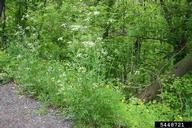| wild chervil | USDA PLANTS Symbol: ANSY U.S. Nativity: Exotic Habit: Forbs/Herbs |
| Anthriscus sylvestris (L.) Hoffmann |
Jump to: Resources | Images | Distribution Maps | Sources
|
Taxonomic Rank: Magnoliopsida: Apiales: Apiaceae |
|
| Synonym(s): bur chervil, cow parsley, keck | |
| Native Range: Europe, West Asia (BAIL); | |
|
|
Identification, Biology, Control and Management Resources
|
| Selected Images from Invasive.org | View All Images at Invasive.org |
 Flower(s); Leslie J. Mehrhoff, University of Connecticut, Bugwood.org Additional Resolutions & Image Usage |
 Flower(s); Leslie J. Mehrhoff, University of Connecticut, Bugwood.org Additional Resolutions & Image Usage |
 Flower(s); Leslie J. Mehrhoff, University of Connecticut, Bugwood.org Additional Resolutions & Image Usage |
 Fruit(s); Leslie J. Mehrhoff, University of Connecticut, Bugwood.org Additional Resolutions & Image Usage |
 Foliage; John Cardina, The Ohio State University, Bugwood.org Additional Resolutions & Image Usage |
 Foliage; Leslie J. Mehrhoff, University of Connecticut, Bugwood.org Additional Resolutions & Image Usage |
 Stem(s); Leslie J. Mehrhoff, University of Connecticut, Bugwood.org Additional Resolutions & Image Usage |
 Stem(s); Leslie J. Mehrhoff, University of Connecticut, Bugwood.org Additional Resolutions & Image Usage |
 Root(s); Leslie J. Mehrhoff, University of Connecticut, Bugwood.org Additional Resolutions & Image Usage |
 Plant(s); Leslie J. Mehrhoff, University of Connecticut, Bugwood.org Additional Resolutions & Image Usage |
| EDDMapS Distribution: This map is incomplete and is based only on current site and county level reports made by experts and records obtained from USDA Plants Database. For more information, visit www.eddmaps.org |
 State List This map identifies those states that list this species on their invasive species list or law. 
|
| Invasive Listing Sources: |
| Pacific Northwest Exotic Pest Plant Council, 1998 |
| WeedUS - Database of Plants Invading Natural Areas in the United States |










